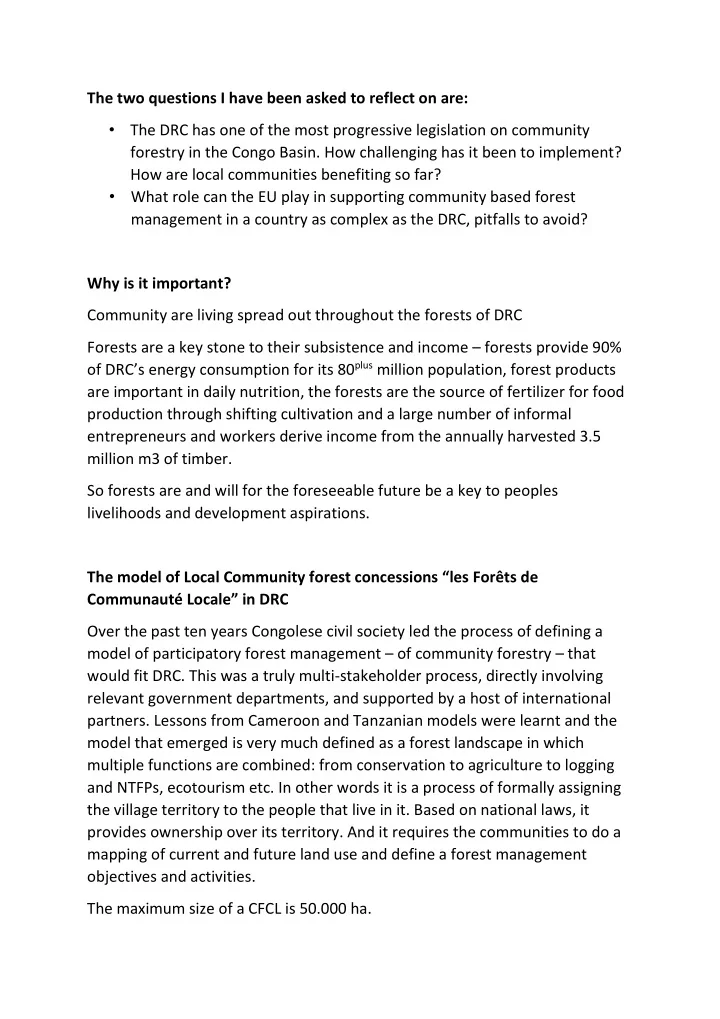

The two questions I have been asked to reflect on are: • The DRC has one of the most progressive legislation on community forestry in the Congo Basin. How challenging has it been to implement? How are local communities benefiting so far? • What role can the EU play in supporting community based forest management in a country as complex as the DRC, pitfalls to avoid? Why is it important? Community are living spread out throughout the forests of DRC Forests are a key stone to their subsistence and income – forests provide 90% of DRC’s energy consumption for its 80 plus million population, forest products are important in daily nutrition, the forests are the source of fertilizer for food production through shifting cultivation and a large number of informal entrepreneurs and workers derive income from the annually harvested 3.5 million m3 of timber. So forests are and will for the foreseeable future be a key to peoples livelihoods and development aspirations. The model of Local Community forest concessions “le s Forêts de Communauté Locale ” in DRC Over the past ten years Congolese civil society led the process of defining a model of participatory forest management – of community forestry – that would fit DRC. This was a truly multi-stakeholder process, directly involving relevant government departments, and supported by a host of international partners. Lessons from Cameroon and Tanzanian models were learnt and the model that emerged is very much defined as a forest landscape in which multiple functions are combined: from conservation to agriculture to logging and NTFPs, ecotourism etc. In other words it is a process of formally assigning the village territory to the people that live in it. Based on national laws, it provides ownership over its territory. And it requires the communities to do a mapping of current and future land use and define a forest management objectives and activities. The maximum size of a CFCL is 50.000 ha.
Does it provide a framework for development? As we have seen YES Does it improve for forest and land governance? Here there are a lot of ifs. The FAO mega study on Community Based Forestry found that there are 6 conditions which must all be met to enable CBF to deliver fully on its objectives: Secure tenure, enabling regulatory framework, strong governance, viable technology, adequate market knowledge, supportive bureaucracy. These same conditions of enabling framework can be applied to any business or integrated development proposal and they are all policies that the EU promotes in the variety of its programmes. Does it result in forests standing – in reducing forest loss The model of Forêt de Communauté Locale as a forest multiple use landscape is very much supported by the integrated REDD+ programmes of DRC. If implemented well it is a framework for sustainable forest management and social and economic development Major challenges Elite capture of the CFCL model for quick gains and access to forest resources Problem of capacity with forest administration – at present it has only 6 staff working on this new model – in the provinces the forest departments are struggling to understand the new model Fulfilling the model of multiple use – and not focusing on just forest exploitation Defining the community Forest enterprise development Developing market value chains for a variety of forest derived products
Drawing the interest of private sector to support value chain development and employment creation To work on these and other challenges there is a 5-yr National Strategy (2018- 2022) to pilot the model – the ministry, with national and international partners has jointly engaged to this strategy Need for a long term commitment to support the DRC model to come to maturity. Long term and consistent support for community forestry has always been lacking What is needed is a long term support programme and the EU has proven to be the only donor capable of engaging in a long term commitment in forest sector – see ECOFAC since 1992 with lots of ups and downs but still going – and VPA FLEGT now 15 years and having had a lot of important impact. We believe there is a strong case for a new EU long term commitment to supporting community and private sector forest landscape development in the Congo Basin. The DRC model provides a good framework to invest in. It would combine work on forest governance, rural development, zero deforestation, food security and poverty alleviation – all in the context of our common SDG and Climate Change agendas.
Recommend
More recommend